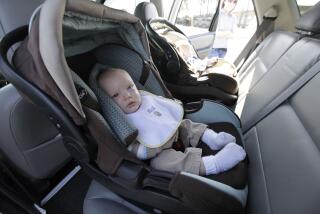Doing Youngsters’ Car Safety the Right Way
- Share via
Autumn Alexander Skeen believes her 4-year-old son might be alive today had he been buckled into a car seat instead of a standard seat belt.
Anton Skeen was killed when the Washington state family’s SUV rolled in an accident on a summer vacation trip in 1996 and his 45-pound body slipped through the seat belt. He landed on the road median and died of head injuries.
Now his mother is campaigning for stricter child car-seat laws and is encouraging parents to put their children in car seats and to use them properly.
“Parents must hope for the best while driving their cars but plan for the worst by using car seats and booster seats,” Skeen said during an emotional speech in Washington, D.C., promoting car-seat safety checkups that will begin in Southern California on Friday to kick off National Child Passenger Safety Week.
The car-seat checkups “offer hope for children and hope for parents that through proper use of car safety seats, they won’t have to face what my family’s faced,” Skeen said.
The national child-passenger safety campaign, funded by corporations including auto makers, will send minivans to every state, offering the free car-seat checkups and other driving safety information.
Nationally, about 85% of car seats are placed in vehicles improperly or used incorrectly by parents, according to Safe Kids.
The group says automobile accidents are the leading cause of death for children age 14 and younger, with about 1,800 fatalities annually. The accidents also cause about 280,000 injuries to children each year.
While many parents try to protect their young children by placing them in car seats, often their well-meaning efforts fail. Common mistakes include not securing the car seats tightly enough and incorrectly buckling in their children.
In accidents, these mistakes frequently lead to abdominal injuries. To prevent such injuries, the straps keeping the child inside the seat should be taut enough so that the parent can only place one finger between it and the child. In addition, the car seat should not move more than an inch in any direction inside the vehicle.
Experts also recommend that until a child is 1 and weighs 20 pounds, he or she should ride in a rear-facing car seat to help prevent head or spinal-cord injuries, and all children under the age of 12 should sit in the back seat. Under California law, children younger than 4 or under 40 pounds must be placed in a car seat.
In California, proposed legislation by state Sen. Jackie Speier would require children aged 4, 5 and 6 to ride in booster seats, which allow lap and shoulder belts designed for adults to fit properly. The bill was sent to Gov. Gray Davis last year. After negotiations with Davis’ office, the bill was taken back by Speier to add height and weight standards.





